ocrim1967
185 posts
Latest Posts by ocrim1967










He faced all this for you, for you to be loved, blessed, glorified, exalted, satisfied, accepted, freed and resurrected.



Blanet: A new class of planet that could form around black holes
The dust clouds around supermassive black holes are the perfect breeding ground for an exotic new type of planet.
Blanets are fundamentally similar to planets; they have enough mass to be rounded by their own gravity, but are not massive enough to start thermonuclear fusion, just like planets that orbit stars. In 2019, a team of astronomers and exoplanetologists showed that there is a safe zone around a supermassive black hole that could harbor thousands of blanets in orbit around it.
The generally agreed theory of planet formation is that it occurs in the protoplanetary disk of gas and dust around young stars. When dust particles collide, they stick together to form larger clumps that sweep up more dust as they orbit the star. Eventually, these clumps grow large enough to become planets.
A similar process should occur around supermassive black holes. These are surrounded by huge clouds of dust and gas that bear some similarities to the protoplanetary disks around young stars. As the cloud orbits the black hole, dust particles should collide and stick together forming larger clumps that eventually become blanets.
The scale of this process is vast compared to conventional planet formation. Supermassive black holes are huge, at least a hundred thousand times the mass of our Sun. But ice particles can only form where it is cool enough for volatile compounds to condense.
This turns out to be around 100 trillion kilometers from the black hole itself, in an orbit that takes about a million years to complete. Birthdays on blanets would be few and far between!
An important limitation is the relative velocity of the dust particles in the cloud. Slow moving particles can collide and stick together, but fast-moving ones would constantly break apart in high-speed collisions. Wada and co calculated that this critical velocity must be less than about 80 meters per second.
source

Curious about how to send research to the International Space Station or how to get involved with NASA missions as a college student? Ask our experts!
Through our Student Payload Opportunity with Citizen Science, or SPOCS, we’re funding five college teams to build experiments for the International Space Station. The students are currently building their experiments focusing on bacteria resistance or sustainability research. Soon, these experiments will head to space on a SpaceX cargo launch! University of Idaho SPOCS team lead Hannah Johnson and NASA STEM on Station activity manager Becky Kamas will be taking your questions in an Answer Time session on Thurs., June 3, from 12-1 p.m. EDT here on our Tumblr! Make sure to ask your question now by visiting http://nasa.tumblr.com/ask. Hannah Johnson recently graduated from the University of Idaho with a Bachelor of Science in Chemical Engineering. She is the team lead for the university’s SPOCS team, Vandal Voyagers I, designing an experiment to test bacteria-resistant polymers in microgravity. Becky Kamas is the activity manager for STEM on Station at our Johnson Space Center in Houston. She helps connect students and educators to the International Space Station through a variety of opportunities, similar to the ones that sparked her interest in working for NASA when she was a high school student. Student Payload Opportunity with Citizen Science Fun Facts:
Our scientists and engineers work with SPOCS students as mentors, and mission managers from Nanoracks help them prepare their experiments for operation aboard the space station.
The Vandal Voyagers I team has nine student members, six of whom just graduated from the Department of Chemical and Biological Engineering. Designing the experiment served as a senior capstone project.
The experiment tests polymer coatings on an aluminum 6061 substrate used for handles on the space station. These handles are used every day by astronauts to move throughout the space station and to hold themselves in place with their feet while they work.
The University of Idaho’s SPOCS project website includes regular project updates showing the process they followed while designing and testing the experiment.
Make sure to follow us on Tumblr for your regular dose of space: http://nasa.tumblr.com.










How Quantum Physics Allows Us To See Back Through Space And Time
"If it weren’t for this rare transition, from higher energy spherical orbitals to lower energy spherical orbitals, our Universe would look incredibly different in detail. We would have different numbers and magnitudes of acoustic peaks in the cosmic microwave background, and hence a different set of seed fluctuations for our Universe to build its large-scale structure out of. The ionization history of our Universe would be different; it would take longer for the first stars to form; and the light from the leftover glow of the Big Bang would only take us back to 790,000 years after the Big Bang, rather than the 380,000 years we get today.
In a very real sense, there are a myriad of ways that our view into the distant Universe — to the farthest reaches of deep space where we detect the earliest signals arising after the Big Bang — that would be fundamentally less powerful if not for this one quantum mechanical transition. If we want to understand how the Universe came to be the way it is today, even on cosmic scales, it’s remarkable how subtly dependent the outcomes are on the subatomic rules of quantum physics. Without it, the sights we see looking back across space and time would be far less rich and spectacular."
What gives the Universe the properties we see today? Is it gravity, working on the largest of cosmic scales? It plays a role, but perhaps ironically, the subatomic physics that governs electron transitions within atoms is maybe even more important.
This is how quantum physics allows us to see as far out in space and as far back in time as we can. Without it, our Universe would be a very different place.





You know what the Mexicans say about the Pacific? They say it has no memory. That’s where I want to live the rest of my life. A warm place with no memory. Open up a little hotel right on the beach. Buy some worthless old boat and fix it up new. Take my guests out charter fishing. Zihuatanejo. In a place like that, I could use a man that knows how to get things.
The Shawshank Redemption (1994) dir. Frank Darabont










Here’s Why Black Holes Are Crullers, Not Donuts
“Just a few years ago, we didn’t even know whether it was a certainty that black holes had an event horizon, as we’d never observed one directly. In 2017, a series of observations were finally taken that could settle the issue. After a wait of two years, the first direct image of a black hole was released, and it showed us that the event horizon was, in fact, real as predicted, and that its properties agreed with Einstein’s predictions.
Now, another two years later, the polarization data has been added into the fold, and we can now reconstruct the magnetic properties of the plasma surrounding the black hole, along with how those features are imprinted onto the emitted photons. We still only have the one black hole that’s been directly imaged, but we can see how the light, the polarization, and the magnetic properties of the plasma surrounding the event horizon all change over time.”
You’ve seen the photo, but have you learned the science? Black holes are crullers, not donuts, and magnetized plasma is the reason why.










Recommended Resource: The Names of God by Ken Hemphill










Ask Ethan: Is There A Fundamental Reason Why E = mc²?
“Einstein’s equation is amazingly elegant. But is its simplicity real or only apparent? Does E = mc² derive directly from an inherent equivalence between any mass’s energy and the square of the speed of light (which seems like a marvelous coincidence)? Or does the equation only exist because its terms are defined in a (conveniently) particular way?”
Quite arguably, Einstein’s E = mc² is the most famous equation in the entire world. And yet, it isn’t obvious why it had to be this way! Could there have been some other speed besides the speed of light that converts mass to energy? Could there have been a multiplicative constant out in front besides “1” to give the right answer? No, no there couldn’t. If energy and momentum are conserved, and particles have the energies and momenta that they do, there’s no other option.
Come learn, at last, why E = mc², and why simply no other alternative will do.











Asperitas and Mammatus
Well-defined, wave-like structures in the underside of the cloud; more chaotic and with less horizontal organization than the variety undulatus. Asperitas is characterized by localized waves in the cloud base, either smooth or dappled with smaller features, sometimes descending into sharp points, as if viewing a roughened sea surface from below. Varying levels of illumination and thickness of the cloud can lead to dramatic visual effects.
Occurs mostly with Stratocumulus and Altocumulus
Mammatus is a cellular pattern of pouches hanging underneath the base of a cloud, typically cumulonimbus rainclouds, although they may be attached to other classes of parent clouds.
source | source | images: x, x, x, x, x, x, x
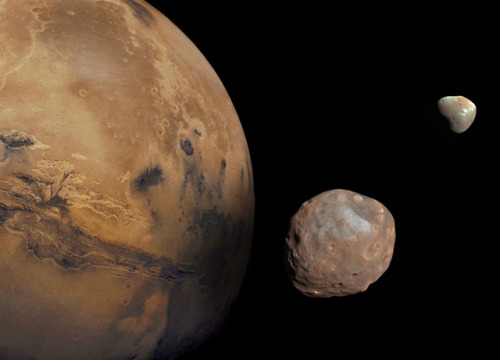
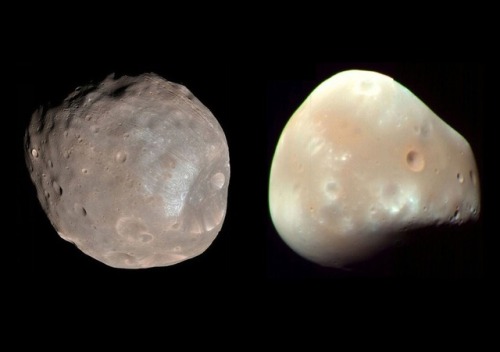

In 40 million years, Mars may have a ring (and one fewer moon)
Nothing lasts forever - especially Phobos, one of the two small moons orbiting Mars. The moonlet is spiraling closer and closer to the Red Planet on its way toward an inevitable collision with its host. But a new study suggests that pieces of Phobos will get a second life as a ring around the rocky planet.
A moon - or moonlet - in orbit around a planet has three possible destinies. If it is just the right distance from its host, it will stay in orbit indefinitely. If it’s beyond that point of equilibrium, it will slowly drift away. (This is the situation with the moon; as it gradually pulls away from Earth, its orbit is growing by about 1.5 inches per year.) And if a moon starts out on the too-close side, its orbit will keep shrinking until there is no distance left between it and its host planet. The Martian ring will last for at least 1 million years - and perhaps for as long as 100 million years, according to the study.
The rest of Phobos will probably remain intact, until it hits the Martian surface. But it won’t be a direct impact; instead, the moonlet’s remains will strike at an oblique angle, skipping along the surface like a smooth stone on a calm lake.
This has probably happened before - scientists believe a group of elliptical craters on the Martian surface were caused by a small moon that skidded to its demise. (If this were to happen on Earth, our planet’s greater mass would produce a crash as big as the one that wiped out the dinosaurs, the researchers noted as an aside.)
source
images: NASA/JPL, Tushar Mittal using Celestia 2001-2010, Celestia Development Team.





Loving Vincent (2017) dir. Dorota Kobiela, Hugh Welchman


Chandra Spots Extremely Long Cosmic Jet in Early Universe
http://www.sci-news.com/astronomy/chandra-extremely-long-cosmic-jet-early-universe-09436.html
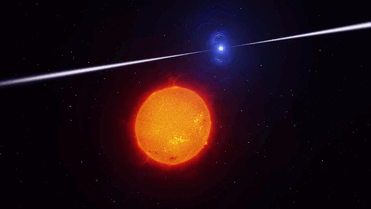
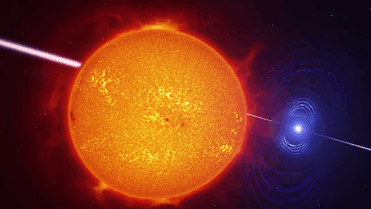
The Scorpii AR system
In the system AR Scorpii a rapidly spinning white dwarf star powers electrons up to almost the speed of light. These high energy particles release blasts of radiation that lash the companion red dwarf star, and cause the entire system to pulse dramatically every 1.97 minutes with radiation ranging from the ultraviolet to radio.
The star system AR Scorpii, or AR Sco for short, lies in the constellation of Scorpius, 380 light-years from Earth. It comprises a rapidly spinning white dwarf, the size of Earth but containing 200,000 times more mass, and a cool red dwarf companion one third the mass of the Sun, orbiting one another every 3.6 hours in a cosmic dance as regular as clockwork.
Read more at: cosmosmagazine & astronomynow
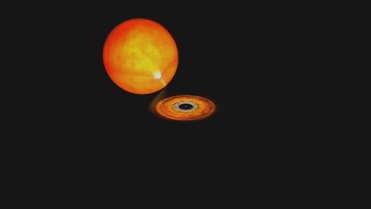

Millisecond Pulsar with Magnetic Field Structure
A pulsar is a rapidly rotating neutron star that emits pulses of radiation (such as X-rays and radio waves) at regular intervals. A millisecond pulsar is one with a rotational period between 1 and 10 milliseconds, or from 60,000 to 6,000 revolutions per minute. Pulsars form in supernova explosions, but even newborn pulsars don’t spin at millisecond speeds, and they gradually slow down with age. If, however, a pulsar is a member of a binary system with a normal star, gas transferred from the companion can spin up an old, slow pulsar to the millisecond range.
Credit: NASA, Dana Berry: Lead Animator Michael McClare (HTSI)

Mother Teresa’s Humility List
1. Speak as little as possible about yourself.
2. Keep busy with your own affairs and not those of others.
3. Avoid curiosity.
4. Do not interfere in the affairs of others.
5. Accept small irritations with good humor.
6. Do not dwell on the faults of others.
7. Accept censures even if unmerited.
8. Give in to the will of others.
9. Accept insults and injuries.
10. Accept contempt, being forgotten and disregarded.
11. Be courteous and delicate even when provoked by someone.



Happy Birthday, Albert Einstein! Genius Scientist Turns 140 Years Old Today.
The year 1905 came to be known as Einstein’s Miracle Year. He was 26 years old, and in that year he published four papers that reshaped physics.
Photoelectric effect
The first explained what’s called the photoelectric effect – one of the bases for modern-day electronics – with practical applications including television. His paper on the photoelectric effect helped pave the way for quantum mechanics by establishing that light is both a particle and a wave. For this work, Einstein was later awarded a Nobel Prize in physics.


Brownian motion
Another 1905 paper related to Brownian motion. In it, Einstein stated that the seemingly random motion of particles in a fluid (Brownian motion) was a predictable, measurable part of the movement of atoms and molecules. This helped establish the Kinetic Molecular Theory of Heat, which says that, if you heat something, its molecules begin to vibrate. At this same time, Einstein provided definitive confirmation that atoms and molecules actually exist.


Special relativity
Also in 1905, Einstein published his Special Theory of Relativity. Before it, space, time and mass all seemed to be absolutes – the same for everyone. Einstein showed that different people perceive mass, space and time differently, but that these effects don’t show up until you start moving nearly at the speed of light. Then you find, for example, that time on a swiftly moving spaceship slows down, while the mass of the ship increases. According to Einstein, a spaceship traveling at the speed of light would have infinite mass, and a body of infinite mass also has infinite resistance to motion. And that’s why nothing can accelerate to a speed faster than light speed. Because of Einstein’s special relativity, light is now seen as an absolute in a universe of shifting values for space, time and matter.

Mass-energy equivalence
The fourth 1905 paper stated that mass and energy are equivalent. You perhaps know something of this work in Einstein’s famous equation E=mc2. That equation means that energy (E) is equal to mass (m) multiplied by the speed of light © squared. Sound simple? It is, in a way. It means that matter and energy are the same thing. It’s also very profound, in part because the speed of light is a huge number. As shown by the equation, a small amount of mass can be converted into a large amount of energy … as in atomic bombs. It’s this same conversion of mass to energy, by the way, that causes stars to shine.
But Einstein didn’t stop there. As early as 1911, he’d predicted that light passing near a large mass, such as a star, would be bent. That idea led to his General Theory of Relativity in 1916.


This paper established the modern theory of gravitation and gave us the notion of curved space. Einstein showed, for example, that small masses such as planets form dimples in space-time that hardly affect the path of starlight. But big masses such as stars produce measurably curved space.





The fact that the curved space around our sun was measurable let other scientists prove Einstein’s theory. In 1919, two expeditions organized by Arthur Eddington photographed stars near the sun made visible during a solar eclipse. The displacement of these stars with respect to their true positions on the celestial sphere showed that the sun’s gravity does cause space to curve so that starlight traveling near the sun is bent from its original path. This observation confirmed Einstein’s theory, and made Einstein a household name.
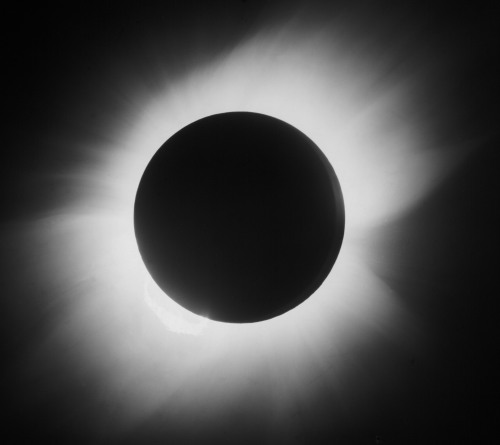
Source (read more) posts about Einstein
What is a Wormhole?
Wormholes were first theorized in 1916, though that wasn’t what they were called at the time. While reviewing another physicist’s solution to the equations in Albert Einstein’s theory of general relativity, Austrian physicist Ludwig Flamm realized another solution was possible. He described a “white hole,” a theoretical time reversal of a black hole. Entrances to both black and white holes could be connected by a space-time conduit.

In 1935, Einstein and physicist Nathan Rosen used the theory of general relativity to elaborate on the idea, proposing the existence of “bridges” through space-time. These bridges connect two different points in space-time, theoretically creating a shortcut that could reduce travel time and distance. The shortcuts came to be called Einstein-Rosen bridges, or wormholes.

Certain solutions of general relativity allow for the existence of wormholes where the mouth of each is a black hole. However, a naturally occurring black hole, formed by the collapse of a dying star, does not by itself create a wormhole.
Wormholes are consistent with the general theory of relativity, but whether wormholes actually exist remains to be seen.

A wormhole could connect extremely long distances such as a billion light years or more, short distances such as a few meters, different universes, or different points in time
For a simplified notion of a wormhole, space can be visualized as a two-dimensional (2D) surface. In this case, a wormhole would appear as a hole in that surface, lead into a 3D tube (the inside surface of a cylinder), then re-emerge at another location on the 2D surface with a hole similar to the entrance. An actual wormhole would be analogous to this, but with the spatial dimensions raised by one. For example, instead of circular holes on a 2D plane, the entry and exit points could be visualized as spheres in 3D space.

Science fiction is filled with tales of traveling through wormholes. But the reality of such travel is more complicated, and not just because we’ve yet to spot one.

The first problem is size. Primordial wormholes are predicted to exist on microscopic levels, about 10–33 centimeters. However, as the universe expands, it is possible that some may have been stretched to larger sizes.
Another problem comes from stability. The predicted Einstein-Rosen wormholes would be useless for travel because they collapse quickly.

“You would need some very exotic type of matter in order to stabilize a wormhole,” said Hsu, “and it’s not clear whether such matter exists in the universe.”
But more recent research found that a wormhole containing “exotic” matter could stay open and unchanging for longer periods of time.

Exotic matter, which should not be confused with dark matter or antimatter, contains negative energy density and a large negative pressure. Such matter has only been seen in the behavior of certain vacuum states as part of quantum field theory.
If a wormhole contained sufficient exotic matter, whether naturally occurring or artificially added, it could theoretically be used as a method of sending information or travelers through space. Unfortunately, human journeys through the space tunnels may be challenging.

Wormholes may not only connect two separate regions within the universe, they could also connect two different universes. Similarly, some scientists have conjectured that if one mouth of a wormhole is moved in a specific manner, it could allow for time travel.

Although adding exotic matter to a wormhole might stabilize it to the point that human passengers could travel safely through it, there is still the possibility that the addition of “regular” matter would be sufficient to destabilize the portal.
Today’s technology is insufficient to enlarge or stabilize wormholes, even if they could be found. However, scientists continue to explore the concept as a method of space travel with the hope that technology will eventually be able to utilize them.
source
source
images: x, x, x, x, x, x, x, x, x
Black holes
A black hole is a region of spacetime exhibiting such strong gravitational effects that nothing—not even particles and electromagnetic radiation such as light—can escape from inside it. The theory of general relativity predicts that a sufficiently compact mass can deform spacetime to form a black hole. The boundary of the region from which no escape is possible is called the event horizon. Although the event horizon has an enormous effect on the fate and circumstances of an object crossing it, no locally detectable features appear to be observed. In many ways a black hole acts like an ideal black body, as it reflects no light.

The idea of a body so massive that even light could not escape was briefly proposed by astronomical pioneer and English clergyman John Michell in a letter published in November 1784. Michell’s simplistic calculations assumed that such a body might have the same density as the Sun, and concluded that such a body would form when a star’s diameter exceeds the Sun’s by a factor of 500, and the surface escape velocity exceeds the usual speed of light.

At the center of a black hole, as described by general relativity, lies a gravitational singularity, a region where the spacetime curvature becomes infinite. For a non-rotating black hole, this region takes the shape of a single point and for a rotating black hole, it is smeared out to form a ring singularity that lies in the plane of rotation. In both cases, the singular region has zero volume. It can also be shown that the singular region contains all the mass of the black hole solution. The singular region can thus be thought of as having infinite density.

How Do Black Holes Form?
Scientists think the smallest black holes formed when the universe began.
Stellar black holes are made when the center of a very big star falls in upon itself, or collapses. When this happens, it causes a supernova. A supernova is an exploding star that blasts part of the star into space.

Scientists think supermassive black holes were made at the same time as the galaxy they are in.
Supermassive black holes, which can have a mass equivalent to billions of suns, likely exist in the centers of most galaxies, including our own galaxy, the Milky Way. We don’t know exactly how supermassive black holes form, but it’s likely that they’re a byproduct of galaxy formation. Because of their location in the centers of galaxies, close to many tightly packed stars and gas clouds, supermassive black holes continue to grow on a steady diet of matter.

If Black Holes Are “Black,” How Do Scientists Know They Are There?
A black hole can not be seen because strong gravity pulls all of the light into the middle of the black hole. But scientists can see how the strong gravity affects the stars and gas around the black hole.
Scientists can study stars to find out if they are flying around, or orbiting, a black hole.

When a black hole and a star are close together, high-energy light is made. This kind of light can not be seen with human eyes. Scientists use satellites and telescopes in space to see the high-energy light.

On 11 February 2016, the LIGO collaboration announced the first observation of gravitational waves; because these waves were generated from a black hole merger it was the first ever direct detection of a binary black hole merger. On 15 June 2016, a second detection of a gravitational wave event from colliding black holes was announced.

Simulation of gravitational lensing by a black hole, which distorts the image of a galaxy in the background
Animated simulation of gravitational lensing caused by a black hole going past a background galaxy. A secondary image of the galaxy can be seen within the black hole Einstein ring on the opposite direction of that of the galaxy. The secondary image grows (remaining within the Einstein ring) as the primary image approaches the black hole. The surface brightness of the two images remains constant, but their angular size varies, hence producing an amplification of the galaxy luminosity as seen from a distant observer. The maximum amplification occurs when the background galaxy (or in the present case a bright part of it) is exactly behind the black hole.
Could a Black Hole Destroy Earth?
Black holes do not go around in space eating stars, moons and planets. Earth will not fall into a black hole because no black hole is close enough to the solar system for Earth to do that.

Even if a black hole the same mass as the sun were to take the place of the sun, Earth still would not fall in. The black hole would have the same gravity as the sun. Earth and the other planets would orbit the black hole as they orbit the sun now.
The sun will never turn into a black hole. The sun is not a big enough star to make a black hole.
More posts about black holes
Source 1, 2 & 3










Why 2020 Might Be The Best Geminid Meteor Shower Of All-Time
“As the large parent body of the Geminids, asteroid 3200 Phaethon, continues on its tight orbit around the Sun, it will continue to expel matter and be torn apart, bit by tiny bit. The asteroid is about the size of the one that struck Earth 65 million years ago, causing our last great mass extinction. But instead of colliding with us all at once, this ~6 km wide asteroid is slowly dissipating in the presence of the Sun, creating tails of matter and ions but also an ever-thickening debris stream.
With each mid-December that rolls past, Earth slams through that debris stream, creating a show that gets progressively more spectacular with each set of orbits that regularly tick by. Over the past 15 years, the Geminids have regularly been one of the two best displays of meteor showers on Earth, and it’s eminently possible that 2020 will set a new record. The Moon, the Earth, and all of the other predictable conditions are just right for a spectacular show. If the clouds cooperate on December 13 and 14, treat yourself to the greatest natural show of the year. With all that 2020 has brought us, we can all use a cosmic treat like this one.”
Can everyone just have a good thing to enjoy? Can we all just have something nice that we don’t have to fight over? Well, nature might deliver what humanity has been unable to bring us for 2020: a natural show that can’t be stopped by anything, except for clouds.
Get your Geminid fix today, and then look up on December 13/14 to fully enjoy the show!





Study Tips Based on Your Hogwarts House
Just finished rewatching all 8 of the Harry Potter films last week… and I thought why not make my first graphic related to it? So, here’s study tips for each of the Hogwarts houses! I know some of these doesn’t apply to everyone, but I had really fun time making this :) Hope this helps!










This Is How The Universe Changes With Every New Year That Passes
“With an 13.8 billion year lifetime so far, the Universe has certainly been around for some time. While it may seem to change only imperceptibly on human timescales, the fact remains that these changes are real, important, and cumulative. If we look closely and precisely enough, we can observe these changes on timescales as small as a single year.
These changes affect not only our home world, but our Solar System, galaxy, and even the entire Universe. We are only in the beginning stages of exploring how the Universe changes over time and what it looks like at the greatest distances and faintest extremes. May the 2020s mark the decade, at long last, where we pool our efforts as a species into the endeavor to uncover the greatest cosmic secrets of all.”
With every year that goes by, tiny, imperceptible changes occur in our physical Universe that really add up over time. The Earth’s rotation is slowing, the Moon is spiraling outwards, the Sun is heating up and new stars are forming. On a cosmic scale, the Universe is expanding and getting cooler, and more galaxies are becoming visible while fewer stars are capable of being visited.
This is how the Universe changes with each new year that passes, and we can quantify the effects today!
Galactic Ghouls and Stellar Screams
A quiet, starry night sky might not seem like a very spooky spectacle, but space can be a creepy place! Monsters lurk in the shadowy depths of the universe, sometimes hidden in plain sight. Many of them are invisible to our eyes, so we have to use special telescopes to see them. Read on to discover some of these strange cosmic beasts, but beware — sometimes fact is scarier than fiction.
Monster Black Holes ⚫

You know those nightmares where no matter how fast you try to run you never seem to get anywhere? Black holes are a sinister possible version of that dream — especially because they’re real! If you get too close to a black hole, there is no possibility of escape.
Just last year our Fermi Gamma-ray Space Telescope traced an otherworldly ghost particle back to one of these monster black holes, providing additional insight into the many signals we’re picking up from some of the most feared creatures in the cosmic deep.
But it gets worse. Our Hubble Space Telescope revealed that these things are hidden in the hearts of nearly every galaxy in the universe. That means supermassive black holes lurk in the shadows of the night sky in every direction you look!
A Hazy Specter 👻

This fiendish specter lives in the center of the Milky Way, haunting our galaxy’s supermassive black hole. But it’s not as scary as it looks! Our SOFIA observatory captured streamlines tracing a magnetic field that appears to be luring most of the material quietly into orbit around the black hole. In other galaxies, magnetic fields seem to be feeding material into hungry black holes — beware! Magnetic fields might be the answer to why some black holes are starving while others are feasting.
Bats in the Belfry 🦇

The universe has bats in the attic! Hubble spotted the shadow of a giant cosmic bat in the Serpens Nebula. Newborn stars like the one at the center of the bat, called HBC 672, are surrounded by disks of material, which are hard to study directly. The shadows they cast, like the bat, can clue scientists in on things like the disk’s size and density. Our solar system formed from the same type of disk of material, but we can only see the end result of planet building here — we want to learn more about the process!
Jack-o-lantern Sun 🎃

A jack-o-lantern in space?! Our Solar Dynamics Observatory watches the Sun at all times, keeping a close eye on space weather. In October 2014, the observatory captured a chilling image of the Sun with a Halloweenish face!
Skull Comet 💀

On Halloween a few years ago, an eerie-looking object known as 2015 TB145 sped across the night sky. Scientists observing it with our Infrared Telescope Facility determined that it was most likely a dead comet. It’s important to study objects like comets and asteroids because they’re dangerous if they cross Earth’s path — just ask the dinosaurs!
Halloween Treat 🍬

Trick-or-treat! Add a piece of glowing cosmic candy to your Halloween haul, courtesy of Hubble! This image shows the Saturn Nebula, formed from the outer layers ejected by a dying star, destined to be recycled into later generations of stars and planets. Our Sun will experience a similar fate in around five billion years.
Witch’s Broom Nebula 🧹

Massive stars are in for a more fiery fate, as the Witch’s Broom Nebula shows. Hubble’s close-up look reveals wisps of gas — shrapnel leftover from a supernova explosion. Astronomers believe that a couple of supernovae occur each century in galaxies like our own Milky Way.
Zombie Stars 🧟

Supernovae usually herald the death of a star, but on a few occasions astronomers have found “zombie stars” left behind after unusually weak supernovae. Our Nuclear Spectroscopic Telescope Array (NuSTAR) has even spotted a mysterious glow of high-energy X-rays that could be the “howls” of dead stars as they feed on their neighbors.
Intergalactic Ghost Towns 🏚️

The universe is brimming with galaxies, but it’s also speckled with some enormous empty pockets of space, too. These giant ghost towns, called voids, may be some of the largest things in the cosmos, and since the universe is expanding, galaxies are racing even farther away from each other all the time! Be grateful for your place in space — the shadowy patches of the universe are dreadful lonely scenes.
Mysterious Invisible Force 🕵️♀️

Some forces are a lot spookier than floorboards creaking or a door slamming shut unexpectedly when you’re home alone. Dark energy is a mysterious antigravity pressure that our Wide Field Infrared Survey Telescope (WFIRST) is going to help us understand. All we know so far is that it’s present everywhere in the cosmos (even in the room with you as you read this) and it controls the fate of the universe, but WFIRST will study hundreds of millions of galaxies to figure out just what dark energy is up to.
Want to learn some fun ways to celebrate Halloween in (NASA) style? Check out this link!
Make sure to follow us on Tumblr for your regular dose of space: http://nasa.tumblr.com









this cat is so cute










This One Thought Experiment Shows Why Special Relativity Isn’t The Full Story
“In Einstein’s initial formulation of General Relativity way back in 1916, he mentioned the gravitational redshift (and blueshift) of light as a necessary consequence of his new theory, and the third classical test, after the precession of Mercury’s perihelion (already known at the time) and the deflection of starlight by a gravitational source (discovered during a total solar eclipse in 1919).
Although a thought experiment is an extremely powerful tool, practical experiments didn’t catch up until 1959, where the Pound-Rebka experiment finally measured a gravitational redshift/blueshift directly. Yet just by invoking the idea that energy must be conserved, and a basic understanding of particle physics and gravitational fields, we can learn that light must change its frequency in a gravitational field.”
If a photon flies through space towards Earth, it must gain energy and become bluer in nature as it approaches Earth’s surface. This idea, of a gravitational redshift or blueshift, dictates how a photon must change in energy in the presence of a gravitational field. Yet this effect, which only exists in General Relativity, could have been predicted as soon as special relativity was discovered by one simple thought experiment: to consider a particle-antiparticle pair dropped from high above the surface of the Earth, but to let the annihilation occur at varying locations.
If you considered that, you’d immediately realize how special relativity was insufficient for describing our Universe! Come learn how to reason it out for yourself today!










This Is What The Milky Way’s Magnetic Field Looks Like
“The Milky Way’s gas, dust, stars and more create fascinating, measurable structures. Subtracting out all the foregrounds yields the cosmic background signal, which possesses tiny temperature imperfections. But the galactic foreground isn’t useless; it’s a map unto itself. All background light gets polarized by these foregrounds, enabling the reconstruction of our galaxy’s magnetic field.”
Have you ever wondered what our galaxy’s magnetic field looks like? As long as we restrict ourselves to looking in the type of light that human eyes can see, the optical portion of the spectrum, we’re extremely limited as far as what we can infer. However, if we move on to data from the microwave portion of the spectrum, and in particular we look at the data that comes from the polarization of background light (and the foreground light directly), we should be able to reconstruct our galaxy’s magnetic fields to the best precision ever. The Planck satellite, in addition to mapping the CMB to better precision than ever before, has enabled us to do exactly that.
Even though there are still some small questions and uncertainties, you won’t want to miss these incredible pictures that showcase just how far we’ve come!
How Do You Solve a Problem Like Dark Energy?

Here’s the deal — the universe is expanding. Not only that, but it’s expanding faster and faster due to the presence of a mysterious substance scientists have named “dark energy.”
But before we get to dark energy, let’s first talk a bit about the expanding cosmos. It started with the big bang — when the universe started expanding from a hot, dense state about 13.8 billion years ago. Our universe has been getting bigger and bigger ever since. Nearly every galaxy we look at is zipping away from us, caught up in that expansion!

The expansion, though, is even weirder than you might imagine. Things aren’t actually moving away from each other. Instead, the space between them is getting larger.
Imagine that you and a friend were standing next to each other. Just standing there, but the floor between you was growing. You two aren’t technically moving, but you see each other moving away. That’s what’s happening with the galaxies (and everything else) in our cosmos … in ALL directions!

Astronomers expected the expansion to slow down over time. Why? In a word: gravity. Anything that has mass or energy has gravity, and gravity tries to pull stuff together. Plus, it works over the longest distances. Even you, reading this, exert a gravitational tug on the farthest galaxy in the universe! It’s a tiny tug, but a tug nonetheless.
As the space between galaxies grows, gravity is trying to tug the galaxies back together — which should slow down the expansion. So, if we measure the distance of faraway galaxies over time, we should be able to detect if the universe’s growth rate slows down.

But in 1998, a group of astronomers measured the distance and velocity of a number of galaxies using bright, exploding stars as their “yardstick.” They found out that the expansion was getting faster.
Not slowing down.
Speeding up.

⬆️ This graphic illustrates the history of our expanding universe. We do see some slowing down of the expansion (the uphill part of the graph, where the roller coaster is slowing down). However, at some point, dark energy overtakes gravity and the expansion speeds up (the downhill on the graph). It’s like our universe is on a giant roller coaster ride, but we’re not sure how steep the hill is!

Other researchers also started looking for signs of accelerated expansion. And they found it — everywhere. They saw it when they looked at individual stars. They saw it in large scale structures of the universe, like galaxies, galaxy groups and clusters. They even saw it when they looked at the cosmic microwave background (that’s what’s in this image), a “baby picture” of the universe from just a few hundred thousand years after the big bang.
If you thought the roller coaster was wild, hold on because things are about to get really weird.
Clearly, we were missing something. Gravity wasn’t the biggest influence on matter and energy across the largest scales of the universe. Something else was. The name we’ve given to that “something else” is dark energy.

We don’t know exactly what dark energy is, and we’ve never detected it directly. But we do know there is a lot of it. A lot. If you summed up all the “stuff” in the universe — normal matter (the stuff we can touch or observe directly), dark matter, and dark energy — dark energy would make up more than two-thirds of what is out there.
That’s a lot of our universe to have escaped detection!
Researchers have come up with a few dark energy possibilities. Einstein discarded an idea from his theory of general relativity about an intrinsic property of space itself. It could be that this bit of theory got dark energy right after all. Perhaps instead there is some strange kind of energy-fluid that fills space. It could even be that we need to tweak Einstein’s theory of gravity to work at the largest scales.
We’ll have to stay tuned as researchers work this out.

Our Wide Field Infrared Survey Telescope (WFIRST) — planned to launch in the mid-2020s — will be helping with the task of unraveling the mystery of dark energy. WFIRST will map the structure and distribution of matter throughout the cosmos and across cosmic time. It will also map the universe’s expansion and study galaxies from when the universe was a wee 2-billion-year-old up to today. Using these new data, researchers will learn more than we’ve ever known about dark energy. Perhaps even cracking open the case!
You can find out more about the history of dark energy and how a number of different pieces of observational evidence led to its discovery in our Cosmic Times series. And keep an eye on WFIRST to see how this mystery unfolds.
Make sure to follow us on Tumblr for your regular dose of space: http://nasa.tumblr.com
5 New Competitions for the Artemis Generation!
A common question we get is, “How can I work with NASA?”
The good news is—just in time for the back-to-school season—we have a slew of newly announced opportunities for citizen scientists and researchers in the academic community to take a shot at winning our prize competitions.
As we plan to land humans on the Moon by 2024 with our upcoming Artemis missions, we are urging students and universities to get involved and offer solutions to the challenges facing our path to the Moon and Mars. Here are five NASA competitions and contests waiting for your ideas on everything from innovative ways to drill for water on other planets to naming our next rover:
1. The BIG Idea Challenge: Studying Dark Regions on the Moon
Before astronauts step on the Moon again, we will study its surface to prepare for landing, living and exploring there. Although it is Earth’s closest neighbor, there is still much to learn about the Moon, particularly in the permanently shadowed regions in and near the polar regions.

Through the annual Breakthrough, Innovative and Game-changing (BIG) Idea Challenge, we’re asking undergraduate and graduate student teams to submit proposals for sample lunar payloads that can demonstrate technology systems needed to explore areas of the Moon that never see the light of day. Teams of up to 20 students and their faculty advisors are invited to propose unique solutions in response to one of the following areas:
• Exploration of permanently shadowed regions in lunar polar regions • Technologies to support in-situ resource utilization in these regions • Capabilities to explore and operate in permanently shadowed regions
Interested teams are encouraged to submit a Notice of Intent by September 27 in order to ensure an adequate number of reviewers and to be invited to participate in a Q&A session with the judges prior to the proposal deadline. Proposal and video submission are due by January 16, 2020.
2. RASC-AL 2020: New Concepts for the Moon and Mars
Although boots on the lunar surface by 2024 is step one in expanding our presence beyond low-Earth orbit, we’re also readying our science, technology and human exploration missions for a future on Mars.
The 2020 Revolutionary Aerospace Systems Concepts – Academic Linkage (RASC-AL) Competition is calling on undergraduate and graduate teams to develop new concepts that leverage innovations for both our Artemis program and future human missions to the Red Planet. This year’s competition branches beyond science and engineering with a theme dedicated to economic analysis of commercial opportunities in deep space.

Competition themes range from expanding on how we use current and future assets in cislunar space to designing systems and architectures for exploring the Moon and Mars. We’re seeking proposals that demonstrate originality and creativity in the areas of engineering and analysis and must address one of the five following themes: a south pole multi-purpose rover, the International Space Station as a Mars mission analog, short surface stay Mars mission, commercial cislunar space development and autonomous utilization and maintenance on the Gateway or Mars-class transportation.
The RASC-AL challenge is open to undergraduate and graduate students majoring in science, technology, engineering, or mathematics at an accredited U.S.-based university. Submissions are due by March 5, 2020 and must include a two-minute video and a detailed seven to nine-page proposal that presents novel and robust applications that address one of the themes and support expanding humanity’s ability to thrive beyond Earth.
3. The Space Robotics Challenge for Autonomous Rovers
Autonomous robots will help future astronauts during long-duration missions to other worlds by performing tedious, repetitive and even strenuous tasks. These robotic helpers will let crews focus on the more meticulous areas of exploring. To help achieve this, our Centennial Challenges initiative, along with Space Center Houston of Texas, opened the second phase of the Space Robotics Challenge. This virtual challenge aims to advance autonomous robotic operations for missions on the surface of distant planets or moons.

This new phase invites competitors 18 and older from the public, industry and academia to develop code for a team of virtual robots that will support a simulated in-situ resource utilization mission—meaning gathering and using materials found locally—on the Moon.
The deadline to submit registration forms is December 20.
4. Moon to Mars Ice & Prospecting Challenge to Design Hardware, Practice Drilling for Water on the Moon and Mars
A key ingredient for our human explorers staying anywhere other than Earth is water. One of the most crucial near-term plans for deep space exploration includes finding and using water to support a sustained presence on our nearest neighbor and on Mars.
To access and extract that water, NASA needs new technologies to mine through various layers of lunar and Martian dirt and into ice deposits we believe are buried beneath the surface. A special edition of the RASC-AL competition, the Moon to Mars Ice and Prospecting Challenge, seeks to advance critical capabilities needed on the surface of the Moon and Mars. The competition, now in its fourth iteration, asks eligible undergraduate and graduate student teams to design and build hardware that can identify, map and drill through a variety of subsurface layers, then extract water from an ice block in a simulated off-world test bed.
Interested teams are asked to submit a project plan detailing their proposed concept’s design and operations by November 14. Up to 10 teams will be selected and receive a development stipend. Over the course of six months teams will build and test their systems in preparation for a head-to-head competition at our Langley Research Center in June 2020.
5. Name the Mars 2020 Rover!
Red rover, red rover, send a name for Mars 2020 right over! We’re recruiting help from K-12 students nationwide to find a name for our next Mars rover mission.
The Mars 2020 rover is a 2,300-pound robotic scientist that will search for signs of past microbial life, characterize the planet’s climate and geology, collect samples for future return to Earth, and pave the way for human exploration of the Red Planet.
K-12 students in U.S. public, private and home schools can enter the Mars 2020 Name the Rover essay contest. One grand prize winner will name the rover and be invited to see the spacecraft launch in July 2020 from Cape Canaveral Air Force Station in Florida. To enter the contest, students must submit by November 1 their proposed rover name and a short essay, no more than 150 words, explaining why their proposed name should be chosen.
Just as the Apollo program inspired innovation in the 1960s and ‘70s, our push to the Moon and Mars is inspiring students—the Artemis generation—to solve the challenges for the next era of space exploration.
For more information on all of our open prizes and challenges, visit: https://www.nasa.gov/solve/explore_opportunities
Make sure to follow us on Tumblr for your regular dose of space: http://nasa.tumblr.com
A Tiny Satellite Studies Stormy Layers

The gif above shows data taken by an experimental weather satellite of Hurricane Dorian on September 3, 2019. TEMPEST-D, a NASA CubeSat, reveals rain bands in four layers of the storm by taking the data in four different radio frequencies. The multiple vertical layers show where the most warm, wet air within the hurricane is rising high into the atmosphere. Pink, red and yellow show the areas of heaviest rainfall, while the least intense areas of rainfall are in green and blue.
How does an Earth satellite the size of a cereal box help NASA monitor storms?

The goal of the TEMPEST-D (Temporal Experiment for Storms and Tropical Systems Demonstration) mission is to demonstrate the performance of a CubeSat designed to study precipitation events on a global scale.
If TEMPEST-D can successfully track storms like Dorian, the technology demonstration could lead to a train of small satellites that work together to track storms around the world. By measuring the evolution of clouds from the moment of the start of precipitation, a TEMPEST constellation mission, collecting multiple data points over short periods of time, would improve our understanding of cloud processes and help to clear up one of the largest sources of uncertainty in climate models. Knowledge of clouds, cloud processes and precipitation is essential to our understanding of climate change.
What is a CubeSat, anyway? And what’s the U for?
CubeSats are small, modular, customizable vessels for satellites. They come in single units a little larger than a rubix cube - 10cmx10cmx10cm - that can be stacked in multiple different configurations. One CubeSat is 1U. A CubeSat like TEMPEST-D, which is a 6U, has, you guessed it, six CubeSat units in it.

Pictured above is a full-size mockup of MarCO, a 6U CubeSat that recently went to Mars with the Insight mission. They really are about the size of a cereal box!
We are using CubeSats to test new technologies and push the boundaries of Earth Science in ways never before imagined. CubeSats are much less expensive to produce than traditional satellites; in multiples they could improve our global storm coverage and forecasting data.
Make sure to follow us on Tumblr for your regular dose of space: http://nasa.tumblr.com